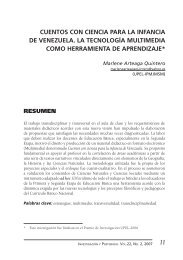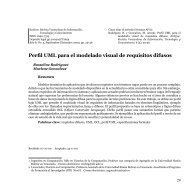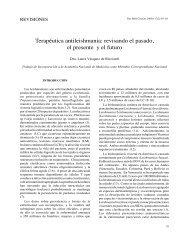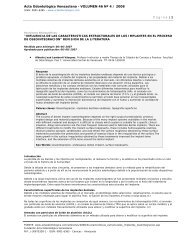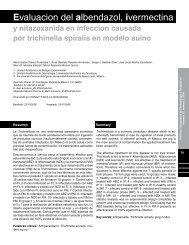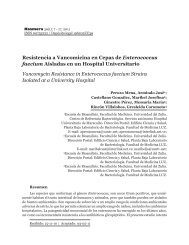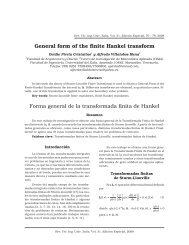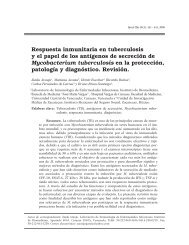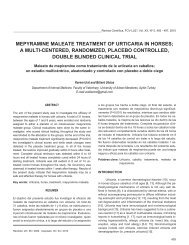Predicting downhole natural separation efficiency by a ... - SciELO
Predicting downhole natural separation efficiency by a ... - SciELO
Predicting downhole natural separation efficiency by a ... - SciELO
Create successful ePaper yourself
Turn your PDF publications into a flip-book with our unique Google optimized e-Paper software.
Rev. Téc. Ing. Univ. Zulia. Vol. 30, Edición Especial, 336 - 343, 2007<br />
<strong>Predicting</strong> <strong>downhole</strong> <strong>natural</strong> <strong>separation</strong> <strong>efficiency</strong><br />
<strong>by</strong> a correlation<br />
Richard Márquez and Mauricio Prado<br />
The University of Tulsa. Arizona, USA. rmarquez@luz.edu.ve; Mauricio-prado@utulsa.edu<br />
Phone: 0414-6137946 (Vzla); 001-918-6315163 (USA).<br />
Abstract<br />
Quantifying the <strong>downhole</strong> <strong>natural</strong> <strong>separation</strong> <strong>efficiency</strong> will help to minimize the presence of free gas<br />
at pump intake and to avoid certain operational problems, such as: gas lock, surging, cavitation, over<br />
heat, among others, in systems of artificial lift <strong>by</strong> pumps. In the last few years, the University of Tulsa Artificial<br />
Lift Projects (TUALP) experimental facilities were used to obtain important experimental data on <strong>natural</strong><br />
<strong>separation</strong>. This data has allowed the development of simplified models such as Alhanati [1] and<br />
Serrano [9]. Even though previous models have been able to estimate the <strong>natural</strong> <strong>separation</strong> <strong>efficiency</strong>,<br />
both models never considered the effect of important variables as the slip velocity in the radial direction<br />
and the geometric characteristic of the bottomhole completion. This paper presents a new correlation obtained<br />
from TUALP experimental data. This work is different than previous simplified models since it considers<br />
the drag effect in the radial direction. This new model represents a simple and reliable tool, which<br />
allows a robust estimate of the <strong>natural</strong> <strong>separation</strong> <strong>efficiency</strong> with a higher accuracy.<br />
Key words: Natural <strong>separation</strong>, free gas, slip velocity, artificial lift.<br />
Predicción de la eficiencia de separación <strong>natural</strong><br />
en fondo de pozo mediante una correlación<br />
Resumen<br />
Cuantificar la eficiencia de separación <strong>natural</strong> en el fondo del pozo permitiría minimizar la presencia<br />
de gas libre a la entrada de la bomba y evitar ciertos problemas operacionales, tales como: fluctuaciones<br />
de producción, cavitación, sobre calentamiento, entre otros, en sistemas de levantamiento artificial mediante<br />
bombas. En los últimos años, las facilidades experimentales del proyecto de levantamiento artificial<br />
de la Universidad de Tulsa (TUALP) han sido utilizadas para obtener importante data experimental sobre<br />
separación <strong>natural</strong>. Esta data ha permitido el desarrollo de modelos simplificados como de Alhanati<br />
[1] y Serrano [9]. Aun cuando estos modelos han permitido estimar la eficiencia de separación <strong>natural</strong>,<br />
ambos modelos nunca han considerado el efecto de importantes variables como la velocidad de deslizamiento<br />
en la dirección radial y las características geométricas de la completación del pozo. Este artículo<br />
presenta una nueva correlación obtenida de data del TUALP. Este trabajo es diferente de anteriores modelos<br />
simplificados ya que considera el efecto de arrastre en la dirección radial. Este nuevo modelo representa<br />
una simple y confiable herramienta, la cual permite estimar la eficiencia de separación <strong>natural</strong> con un<br />
alto grado de exactitud.<br />
Palabras clave: Separación <strong>natural</strong>, gas libre, velocidad de deslizamiento, levantamiento artificial.<br />
Rev. Téc. Ing. Univ. Zulia. Vol. 30, Edición Especial, 2007
<strong>Predicting</strong> <strong>downhole</strong> <strong>natural</strong> <strong>separation</strong> <strong>efficiency</strong> <strong>by</strong> a correlation 337<br />
I. Introduction<br />
Since 1993, Tulsa University Artificial Lift<br />
Projects (TUALP) has been conducting important<br />
research in the area of <strong>natural</strong> <strong>separation</strong>. It has<br />
permitted gathering experimental data, using air<br />
and water, to develop, test, validate, and improve<br />
different correlations and models for estimating<br />
<strong>natural</strong> <strong>separation</strong> <strong>efficiency</strong>. Based on the<br />
drift-flux model and assuming no slip velocity in<br />
the radial direction, in front of the pump intake,<br />
some simplified models have been developed at<br />
TUALP, such as: Alhanati’s [1] and Serrano’s [9]<br />
models. Although these models have captured<br />
the physics involved in the problem, results have<br />
shown that they do not work very well for all operational<br />
conditions. On the other hand, simplified<br />
models do not consider the effect of important<br />
variables, such as: gas flow rate, pressure, geometric<br />
characteristics of the bottomhole and drag<br />
force in the radial direction, which have shown to<br />
have a strong effect on the <strong>natural</strong> <strong>separation</strong><br />
process. A new assumption (the existence of the<br />
slip velocity in the radial direction) has allowed<br />
obtaining a new mathematical formulation for<br />
the problem. Available experimental data was<br />
used to develop a new correlation. Results obtained<br />
for the new simplified model show the<br />
strong effect that the drag force has on the <strong>separation</strong><br />
process. The new simplified model, with<br />
along the new correlation, represent an important<br />
change in the methodology used to predict<br />
<strong>natural</strong> <strong>separation</strong> <strong>efficiency</strong>.<br />
II. General Formulation<br />
of the New Simplified Model<br />
A single control volume situated in front of<br />
the pump intake is showed in Figure 1. Three assumptions<br />
will be considered valid. The first<br />
states that: the gas void fraction g is considered<br />
uniform across to the annulus domain and holds<br />
constant up to the pump intake port. The second<br />
considers that the liquid column in the annulus<br />
in front and above the pump intake is not flowing<br />
in the vertical direction; it flows only in a radial<br />
direction towards the pump intake. The third<br />
considers the existence of slip velocity between<br />
gas and liquid phases at the vertical and radial<br />
direction.<br />
Casing Wall<br />
Assuming constant density, mass balance<br />
equation would allow establishing the following<br />
volumetric balance around the single control volume<br />
(as shown in Figure 2):<br />
Q<br />
i<br />
l<br />
i<br />
p<br />
l<br />
Q , (1)<br />
p<br />
Qg<br />
Qg<br />
Qgp, (2)<br />
i<br />
where Q l<br />
and Q p<br />
l<br />
represent the liquid flow rate<br />
coming from the annulus and liquid flow rate going<br />
inside the pump, respectively. Similarly, Q i g ,<br />
Q p<br />
gp<br />
and Q g are the gas flow rate coming from the<br />
annulus, gas flow rate going into the pump and<br />
the gas flow rate vented, respectively. On the<br />
other hand, <strong>natural</strong> <strong>separation</strong> <strong>efficiency</strong> is defined<br />
as the ratio of the gas flow rate vented to the<br />
gas flow rate coming from the annulus, i.e.,<br />
Q g<br />
E i<br />
. (3)<br />
Q<br />
g<br />
Gas flow rate can also be expressed as a<br />
function of superficial velocity and flow area, i.e.,<br />
p<br />
p<br />
Qgp<br />
VrsgA<br />
i i<br />
Q V A<br />
g<br />
zsg<br />
where V p<br />
rsg<br />
p<br />
Ann<br />
Annulus Outlet<br />
g<br />
A Ann<br />
Annulus Inlet<br />
, (4)<br />
i<br />
and V zsg<br />
A p<br />
Pump Wall<br />
Shaft<br />
Pump Intake<br />
represent the superficial gas<br />
velocity going into the pump and the superficial<br />
gas velocity coming from the annulus, respectively.<br />
A p and A Ann<br />
are the area of the port and the<br />
r<br />
Figure 1. Single Cell Domain.<br />
Z<br />
Rev. Téc. Ing. Univ. Zulia. Vol. 30, Edición Especial, 2007
338 Márquez and Prado<br />
annulus, respectively. Combining Eqs. 1 to 4,<br />
<strong>natural</strong> <strong>separation</strong> <strong>efficiency</strong> would be given <strong>by</strong>:<br />
p<br />
V A <br />
rsg p<br />
E 1 <br />
i . (5)<br />
V A <br />
zsg<br />
Ann<br />
Q gv<br />
r<br />
Z<br />
Based on a single control volume, as shown<br />
in Figure 3, the following velocities field for gas<br />
and liquid phases, respectively, would be assumed<br />
valid in this work.<br />
g<br />
p<br />
Q l<br />
p<br />
Q gp<br />
V V ; V V<br />
, (6)<br />
zg<br />
i<br />
zg<br />
rg<br />
p<br />
rg<br />
p<br />
zl rl rl<br />
V 0 ; V V<br />
. (7)<br />
i<br />
Q g<br />
i<br />
Q l<br />
The slip velocity V s is defined as:<br />
Figure 2. Flow Rates Distribution around<br />
the Control Volume.<br />
Vs Vg Vl<br />
, (8)<br />
Z<br />
where V g and V l<br />
represent the average actual gas<br />
r<br />
and liquid velocity, respectively. In the radial direction,<br />
the slip velocity definition given <strong>by</strong> Eq. 8,<br />
allows to obtain the following equation:<br />
V __<br />
rl<br />
V __<br />
zg<br />
V __<br />
g<br />
rg<br />
p<br />
V<br />
p p rsg Vrsl<br />
Vrs Vrg Vrl Vrg<br />
Vrl<br />
, (9)<br />
( 1 )<br />
p<br />
g<br />
g<br />
V __<br />
rg<br />
where V p rg and V p rl<br />
represent the actual gas and<br />
liquid velocity, respectively, going into the pump.<br />
Combining Eqs. 1 and 9, the following equation<br />
for V p<br />
rsg can be written as:<br />
Liquid Phase Flow<br />
Gas Phase Flow<br />
Figure 3. Velocities Field into the Control<br />
Volume. Gas and Liquid Phase Flow.<br />
<br />
A <br />
V<br />
p<br />
g<br />
i Ann<br />
Vrsg<br />
Vrs g V<br />
rs and V zs , respectively. Using the drift-flux<br />
( 1 ) <br />
zsl<br />
g<br />
A <br />
. (10)<br />
1 <br />
model approach proposed <strong>by</strong> Ishii [5], the slip velocity<br />
V s at any direction can be related to the ter-<br />
<br />
p <br />
<br />
minal velocity of a particleV . This relationship is<br />
At the vertical direction, the slip velocity given <strong>by</strong>:<br />
definition given <strong>by</strong> Eq. 9 and the assumptions<br />
considered previously can be used to obtain the<br />
n1<br />
Vs<br />
V( 1 g)<br />
. (12)<br />
following equation:<br />
i<br />
n represents the effect due to the presence<br />
V<br />
i zsg<br />
Vzs<br />
Vzg<br />
. (11) of others bubbles and may be negligible under<br />
g<br />
churn flow regime. Since most of the available experimental<br />
data is mainly under this flow regime,<br />
The solution of Eqs. 10 and 11 depends on then n will be assumed equal to zero. Therefore,<br />
two additional unknown variables, i.e. the slip Eq. 12 allows rewrite Eqs. 10 and 11 as a function<br />
of the terminal velocity (V z and V r<br />
velocity in the radial and vertical direction, V rs ).<br />
Rev. Téc. Ing. Univ. Zulia. Vol. 30, Edición Especial, 2007
<strong>Predicting</strong> <strong>downhole</strong> <strong>natural</strong> <strong>separation</strong> <strong>efficiency</strong> <strong>by</strong> a correlation 339<br />
<br />
p<br />
g<br />
i<br />
Vrsg<br />
Vr<br />
V<br />
<br />
<br />
1 g<br />
<br />
i<br />
zsl<br />
<br />
A<br />
<br />
A<br />
Ann<br />
p<br />
<br />
<br />
, (13)<br />
<br />
<br />
g<br />
Vzsg<br />
1 <br />
. (14)<br />
g V <br />
z<br />
Combining Eqs. 13 and 14 and replacing<br />
into Eq. 5, <strong>natural</strong> <strong>separation</strong> <strong>efficiency</strong> would be<br />
finally given <strong>by</strong>:<br />
Velocity at vertical direction V z can be determined<br />
<strong>by</strong> using the Ishii’s model. According to<br />
Ishii [6], V z for bubbly and slug/churn flow regime<br />
is given <strong>by</strong>:<br />
V<br />
z <br />
(<br />
l<br />
g<br />
) g <br />
<br />
<br />
<br />
2<br />
2<br />
l<br />
1/<br />
4<br />
. (16)<br />
Therefore, the only unknown variable is the<br />
parameter called X, defined from Eq. 15 as:<br />
V A<br />
i<br />
r p Vzsl<br />
E <br />
<br />
<br />
<br />
1 <br />
<br />
. (15)<br />
<br />
V <br />
A V <br />
z<br />
Ann<br />
z<br />
X<br />
V<br />
<br />
V<br />
r<br />
z<br />
A<br />
<br />
<br />
<br />
<br />
A<br />
p<br />
Ann<br />
<br />
E<br />
V i<br />
<br />
<br />
zsl<br />
1 <br />
. (17)<br />
V <br />
z<br />
Eq. 15 depends on superficial liquid velocity<br />
V zsl<br />
i<br />
, geometric configuration of the bottomhole<br />
Ap<br />
/ AAnn, and the terminal velocity ratio<br />
Vr<br />
/ Vz. Terminal velocity at vertical direction<br />
V z can be estimated from models such as<br />
Harmathy [3], Wallis [10], Ishii and Zuber [6],<br />
among others. The geometric characteristics of<br />
the bottomhole can also be easily determined.<br />
The problem is how to estimate the terminal velocity<br />
in the radial direction V r . In this paper, a<br />
correlation will be showed as a solution for V r .<br />
III. New Correlation<br />
According to Eq. 15, <strong>natural</strong> <strong>separation</strong> <strong>efficiency</strong><br />
E and superficial liquid velocity coming<br />
i<br />
from the annulus V zsl<br />
are two known variables,<br />
because experimental data, gathered at TUALP<br />
since 1993, is available for this work. Terminal<br />
The available experimental data for <strong>natural</strong><br />
<strong>separation</strong> <strong>efficiency</strong> allowed plotting a graph of<br />
i<br />
X vs. Vzsl<br />
/ Vz , as shown in Figure 4. According<br />
to Figure 4, for low liquid flow rates the slip effect<br />
in the radial direction can be negligible. Therefore,<br />
the assumption of no slip velocity in the radial<br />
direction, considered <strong>by</strong> Alhanati, would result<br />
valid. However, for higher liquid flow rates<br />
this assumption cannot be considered anymore.<br />
Serrano corroborated this fact later when extended<br />
Alhanati’s model <strong>by</strong> gathering extra experimental<br />
data for higher liquid and gas flow<br />
rates. Alhanati’s model failed to match the data<br />
taken <strong>by</strong> Serrano. Consequently, Serrano tried<br />
to obtain a better model <strong>by</strong> developing an empirical<br />
correlation to predicting the local gas void<br />
fraction for the region in front of the pump inlet<br />
ports, assuming no slip velocity in the radial direction.<br />
2<br />
0<br />
0 1 2 3 4 5 6 7 8 9 10<br />
-2<br />
X Parameter<br />
-4<br />
-6<br />
-8<br />
-10<br />
V zsl/V zoo<br />
EXP. DATA - ALHANATI EXP. DATA - SAMBANGI EXP. DATA - SERRANO<br />
Figure 4. X Parameter.<br />
Rev. Téc. Ing. Univ. Zulia. Vol. 30, Edición Especial, 2007
340 Márquez and Prado<br />
The new model proposed assumes the existence<br />
of the slip velocity in the radial direction<br />
and its effect could be considered <strong>by</strong> developing a<br />
correlation from Figure 4. Using a nonlinear regression<br />
model, the following correlation for X parameter<br />
was found.<br />
<br />
<br />
ab c <br />
<br />
V V<br />
X 11<br />
<br />
i<br />
V<br />
b <br />
<br />
<br />
Vz<br />
i<br />
zsl<br />
z<br />
d<br />
zsl<br />
<br />
d<br />
<br />
<br />
<br />
<br />
<br />
<br />
<br />
<br />
<br />
272<br />
V<br />
<br />
V<br />
i<br />
zsl<br />
z<br />
<br />
<br />
272<br />
1/ 272<br />
<br />
<br />
<br />
<br />
<br />
<br />
<br />
,<br />
(18)<br />
where the coefficients a,b,c and d are given <strong>by</strong>:<br />
Finally, <strong>natural</strong> <strong>separation</strong> <strong>efficiency</strong> may<br />
be calculated <strong>by</strong>:<br />
<br />
ab c V i<br />
d<br />
<br />
zsl<br />
<br />
<br />
<br />
<br />
Vz<br />
<br />
E <br />
<br />
<br />
<br />
1<br />
<br />
i<br />
d<br />
Vzsl<br />
b <br />
<br />
<br />
<br />
<br />
<br />
<br />
V<br />
<br />
<br />
z<br />
<br />
.<br />
272<br />
V<br />
<br />
V<br />
i<br />
zsl<br />
z<br />
<br />
<br />
272<br />
1/<br />
272<br />
<br />
<br />
<br />
<br />
<br />
<br />
<br />
V<br />
<br />
V<br />
i<br />
zsl<br />
z<br />
(19)<br />
A graph of New Model Predicted Efficiency<br />
vs. Measured Efficiency from TUALP data bank is<br />
shown in Figure 5.<br />
IV. Results and Discussions<br />
Model Comparisons<br />
<br />
<br />
<br />
The evaluation of this study was based on<br />
statistical parameters given <strong>by</strong> average percentage<br />
error E1, absolute average percentage error<br />
E2 and the standard deviation E3.<br />
N<br />
1<br />
E1<br />
<br />
e N ri 100, (20)<br />
<br />
i1<br />
N<br />
1<br />
E2<br />
<br />
e N ri 100, (21)<br />
<br />
E3<br />
<br />
i1<br />
N<br />
2<br />
1 E1<br />
<br />
eri<br />
<br />
100<br />
N 1i<br />
1<br />
100<br />
, (22)<br />
<br />
<br />
where N represents the number of data points.<br />
On the other hand, the error e ri is given <strong>by</strong>:<br />
e<br />
ri<br />
E<br />
<br />
E<br />
E<br />
cal , i meas,<br />
i<br />
meas,<br />
i<br />
. (23)<br />
The performance of the new simplified<br />
model proposed in this paper was compared with<br />
others simplified models, such as: Alhanati and<br />
Serrano. Results have been divided in two categories,<br />
as follow: For low gas void fraction, it was<br />
found a 14.41% of average error in the prediction<br />
of <strong>natural</strong> <strong>separation</strong> <strong>by</strong> using the new correlation.<br />
For high gas void fraction, the error is much<br />
lower compared with the others simplified models.<br />
The overall performance of Alhanati’s model<br />
represents a 25.64% against of 17.43% of the<br />
new simplified model proposed.<br />
Drag Effect<br />
1.00<br />
0.90<br />
0.80<br />
Predicted Efficiency<br />
0.70<br />
0.60<br />
0.50<br />
0.40<br />
0.30<br />
0.20<br />
0.10<br />
0.00<br />
0.00 0.10 0.20 0.30 0.40 0.50 0.60 0.70 0.80 0.90 1.00<br />
Measured Efficiency<br />
EXP. DATA - ALHANATI EXP. DATA - SAMBANGI EXP. DATA - SERRANO<br />
Figure 5. Predicted vs. Measured Natural Separation Efficiency. New Correlation.<br />
Rev. Téc. Ing. Univ. Zulia. Vol. 30, Edición Especial, 2007
<strong>Predicting</strong> <strong>downhole</strong> <strong>natural</strong> <strong>separation</strong> <strong>efficiency</strong> <strong>by</strong> a correlation 341<br />
According to Figure 4, the slip in the radial<br />
direction can be negligible for low liquid flow<br />
rates. However, this assumption cannot be considered<br />
anymore for high liquid flow rates. The<br />
new correlation takes in account that effect, so<br />
predictions on <strong>natural</strong> <strong>separation</strong> will able to be<br />
estimated with higher accuracy, as a shown in<br />
Figure 5.<br />
Effect of Viscosity<br />
Unfortunately, the model proposed for V z<br />
does not allow considering the bubble size and<br />
viscosity effect. However, other formulations for<br />
C d<br />
would be able to be used instead of recommended<br />
<strong>by</strong> Harmathy [3]. For example, if the following<br />
correlation is considered forC d<br />
(Stoke flow<br />
condition),<br />
C d<br />
24<br />
Re , (24)<br />
p<br />
where, the particle Reynolds number Re p is defined<br />
as:<br />
2r V<br />
<br />
. (25)<br />
d s l<br />
Re p <br />
l<br />
The terminal velocity in the vertical direction<br />
V z would be given <strong>by</strong>:<br />
V<br />
z <br />
2<br />
de<br />
l<br />
2 r<br />
9 <br />
( ) g. (26)<br />
l<br />
g<br />
As a consequence, the Eq. 26 would be able<br />
to be used in order to consider the viscosity and<br />
the bubble size effect in the prediction of <strong>natural</strong><br />
<strong>separation</strong> <strong>efficiency</strong>. However, one additional<br />
closure relationship for the drag radius r d<br />
would<br />
be required in this case.<br />
Effect of Geometry<br />
The model was used to predict <strong>natural</strong> <strong>separation</strong><br />
<strong>efficiency</strong> for a 4 in. pump diameter inside<br />
5, 7 and 10 in. casings. According to<br />
Figure 6, <strong>natural</strong> <strong>separation</strong> <strong>efficiency</strong> increases<br />
as the annulus area increases.<br />
Effect of Gas<br />
Lea and Bearden [7] conducted tests with<br />
500 series equipment inside a 7” casing, with air<br />
and water as experimental fluids at low pressures<br />
(25 to 30 Psig). According to their results,<br />
<strong>natural</strong> <strong>separation</strong> <strong>efficiency</strong> increases as the<br />
in-situ-free gas increases. Alhanati and<br />
Sambangi also reported the same observation.<br />
Unfortunately, the new correlation is not sensible<br />
to the gas flow rate. It does not appear to have any<br />
effect in the prediction of <strong>natural</strong> <strong>separation</strong>.<br />
Effect of Pressure<br />
Experiments have captured the effect of<br />
that variable in the <strong>separation</strong> process. However,<br />
the new simplified model, with along the new correlation,<br />
does not incorporate the effect of that<br />
variable in the prediction of <strong>natural</strong> <strong>separation</strong>.<br />
The only possible effect is through the fluid physical<br />
property calculation given <strong>by</strong> Eq. 16. The new<br />
Efficiency<br />
1.0<br />
0.9<br />
0.8<br />
0.7<br />
0.6<br />
0.5<br />
0.4<br />
0.3<br />
0.2<br />
0.1<br />
0.0<br />
0 500 1000 1500 2000 2500 3000 3500 4000 4500<br />
Liquid Flow Rate (BPD)<br />
Dc=5in Dc=7in Dc=10in<br />
Dp = 4 in<br />
Figure 6. Effect of Geometry on Natural Separation Efficiency.<br />
Rev. Téc. Ing. Univ. Zulia. Vol. 30, Edición Especial, 2007
342 Márquez and Prado<br />
simplified model developed should be improved<br />
to better incorporate the pressure effects observed<br />
in the experimental data.<br />
V. Conclusions and<br />
Recommendations<br />
This new model considers the effect of slip<br />
velocity in the radial direction, a variable neglected<br />
in previous simplified models. In addition,<br />
this variable is considered through a new<br />
and reliable correlation obtained from available<br />
experimental data at TUALP.<br />
Results obtained in this work show the<br />
strong effect that slip velocity has in the prediction<br />
of <strong>natural</strong> <strong>separation</strong> <strong>efficiency</strong>, not only in<br />
the vertical direction, but also in the radial direction,<br />
especially for high liquid flow rates.<br />
The new model presented in this work need<br />
to be improved. Variables such as gas void fraction<br />
and gas flow rate must be considered in the<br />
prediction of <strong>natural</strong> <strong>separation</strong>, because experimental<br />
results have shown have theirs effect on<br />
the <strong>separation</strong> process.<br />
Additional real experimental data is required<br />
to further verify the results obtained <strong>by</strong><br />
using this new correlation. In addition, the viscosity<br />
effect could be considered and analyzed.<br />
A =<br />
D =<br />
E =<br />
Q =<br />
V =<br />
Area, in.<br />
Subscripts<br />
VI. Nomenclature<br />
Diameter, in.<br />
Natural Separation Efficiency<br />
Flow Rate, BD<br />
Velocity, ft/sec<br />
Ann= Annulus<br />
c = Casing<br />
g = Gas<br />
i = Inlet<br />
l = Liquid<br />
p = Port, Pump<br />
t = Tubing<br />
s = Slip, Superficial<br />
r, z = Direction<br />
VII. Acknowledgements<br />
Authors wish to thank Eni-Agip, Centrilift,<br />
Pemex, Pdvsa-Intevep, Ongc, Schlumberger,<br />
Shell and Totalfinalelf for supporting this study.<br />
References<br />
1. Alhanati, F.J.S.: “Bottomhole Gas Separation<br />
Efficiency in Electrical Submersible<br />
Pump Installation”, Dissertation. The University<br />
of Tulsa, 1993.<br />
2. Ghauri, W.K.: “Production Technology Experience<br />
in a Large Carbonate Water-Flood,<br />
Denver Unit, Wasson San Andres Field, West<br />
Texas”, paper SPE 8406 presented at the<br />
1979 SPE Annual Technical Conference and<br />
Exhibition, Las Vegas, NV, Sep. 23-26.<br />
3. Harmathy, T.Z.: Velocity of Large Drops and<br />
Bubbles in Media of Infinite or Restricted Extent,<br />
AIChE, 6, 281(1960).<br />
4. Harun, A.F., Prado, M.G., Serrano, J.C. and<br />
Doty, D.R.: “A Simple Model to Predict Natural<br />
Gas Separation Efficiency in Pumped<br />
Wells”, paper SPE 63045 presented at the<br />
2000 SPE Annual Technical Conference and<br />
Exhibition held in Dallas, Texas, 1-4 October<br />
2000.<br />
5. Ishii, M.: “Thermo Fluid Dynamic Theory of<br />
Two Phase Flow”, Eyrolles, Paris, 1975.<br />
6. Ishii, M. and Zuber, N.: “Drag Coefficient and<br />
Relative Velocity in Bubbly, Droplet or Particulate<br />
Fluids”, AIChE Journal (September<br />
1979) 25, No. 5, 843-855.<br />
7. Lea, J.F. “Effect of Gaseous Fluids on Submersible<br />
Pump Performance”, paper SPE<br />
9218 presented at the 1980 SPE Annual<br />
Technique Conference and Exhibition, Dallas,<br />
TX. (Sep. 21-24).<br />
8. Marquez, R., “Classification of the experimental<br />
<strong>natural</strong> <strong>separation</strong> data according to<br />
flow pattern regime”. Technical Report. The<br />
University of Tulsa, Tulsa, Ok. (2002).<br />
9. Serrano, J.C.: “Natural Separa Ishii, M.:<br />
“Thermo Fluid Dynamic Theory of Two Phase<br />
Flow”, Eyrolles, Paris, 1975.tion Efficiency in<br />
Electric Submersible Pump Systems”, Dissertation.<br />
The University of Tulsa, 1999.<br />
Rev. Téc. Ing. Univ. Zulia. Vol. 30, Edición Especial, 2007
<strong>Predicting</strong> <strong>downhole</strong> <strong>natural</strong> <strong>separation</strong> <strong>efficiency</strong> <strong>by</strong> a correlation 343<br />
10. Wallis, G.B.: “The Terminal Speed of Single<br />
Drops or Bubbles in an Infinite Medium”, International<br />
Journal of Multiphase Flow<br />
(1974) 1, 491-511.<br />
11. Zuber, N.: “On the Dispersed Two-Phase<br />
Flow in the Laminar Flow Regime”, Chem.<br />
Eng. Sci., 19, 897 (1964).<br />
Recibido el 30 de Junio de 2006<br />
En forma revisada el 30 de Julio de 2007<br />
Rev. Téc. Ing. Univ. Zulia. Vol. 30, Edición Especial, 2007




